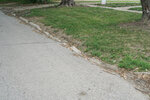



When I was a young man in Storm Lake 60 years ago, the city’s summer street improvement projects resurfaced 12 to 20 blocks every year with asphalt, and streets that were really in need were rebuilt with concrete.
That street program continued through the 1960s and 1970s, but at some point it fell by the wayside, probably because over a couple decades all the streets were brought up to snuff and there were other needs to be met. For most residential streets in Storm Lake, that’s the last time they received any attention.
In the 39 years we have lived in our home on Cayuga Street, there has been no major maintenance on our street or any others in the neighborhood. Until recent years Cayuga hasn’t needed much attention. But the concrete base and water and sewer utilities underground are probably older than 100 years. Maybe much older, since the city was incorporated 151 years ago, and Cayuga — one of The City Beautiful’s original streets — was also one of the first paved.
Traffic engineers estimate the life of a concrete street at 50 to 60 years under normal traffic, and asphalt overlay adds 20 to 25 years. We’re way past our due date.
So are many Storm Lake streets — in fact, just about every street south of Fifth, from Buena Vista University east to Mae, which encompasses most of the original town. Main thoroughfares like Fifth, Third and Lakeshore Drive have been rehabilitated over the last 40 years, but not much else.
Last summer, before we welcomed 30,000 RAGBRAI officers to town, the city spread tar and crushed rock on North Lake Avenue in a slapdash rejuvenation attempt that looked like we were Dogpatch, churning up dust and rocks as traffic moved on one of our city’s most heavily traveled routes. Flindt Drive, the much-used belt around the original city center, is also worn out, particularly by truck traffic to the Tyson packing plants.
So we have a growing number of streets in need of repair: Geneseo, Otsego, Ontario, Cayuga. Some are in desperate shape: West Fourth from Geneseo to BVU, Seneca and Second (around St. Mary’s). They get worse farther east: Hudson, Oneida and Superior. And probably the most neglected street in town, the three short blocks of Irving. I know because I’ve driven them all in recent weeks as the concern grows about our town’s infrastructure issues.
Streets that were resurfaced within the last 20 years already need repair. West Fifth and East Fourth have developed open seams lengthening and widening into crevasses, where the asphalt lanes are pulling apart.
Some of these streets are missing long stretches of pavement and curbs, victims of our harsh winters and snowplows. These broken streets wreak havoc on car suspensions, and the missing curbs cause problems draining heavy rains into storm sewers. It’s a safety issue too — dodging a roadway hazard may cause an accident or flip a bicyclist. For a while the street department can fill the potholes, but at some point, it becomes a losing proposition as the potholes grow to craters.
If you think the ride is tough on cars, try a bicycle. I did last week, riding a mile from near Chautauqua Park to a house on the northwest side of town. The butt-rattling bumps from all the expansion joints that have heaved up into mini speed bumps left my backside in need of a chiropractor.
Maintaining city facilities isn’t much different than your house. I speak from experience. We live in an 88-year-old home and our place is the kid on the block, surrounded by homes that are well over 100 years old. They require constant attention. In the past few years we’ve had to reroof, replace our windows, rebuild our front steps, replace the plumbing in our bathrooms, install new heating and air conditioning, replace portions of our sidewalks and driveway in addition to painting the old barn when it needs it (which is getting close). We can’t afford to do it all at once so we spread the work out over years. If you don’t keep up with the routine maintenance, the place will fall down.
That’s where the city is with infrastructure, particularly our streets (and water system — but that’s another discussion).
Our city administration inherited a problem that has been festering for decades and now it’s time to pay the piper. The answer to this problem is obvious: money. And we don’t have enough, of course.
But we have to do something now. This problem is only going to worsen as Father Time and Mother Nature wear out these streets even faster.
Unfortunately the state has put its cities in a financial straitjacket.
Assistant City Manager David Derragon, who oversees Storm Lake’s public services, told the Hy-Noon Kiwanis Club Monday that 30% of our 50 miles of streets need immediate rehabilitation. He estimates we need to spend $3 million a year to rebuild our streets, which is 50% more than our current street maintenance budget.
Street construction is supposed to be funded by state road use tax funds. But that revenue is basically flat to falling, Derragon says. The state last raised the gas tax in 2015 by a dime a gallon to 31 cents, but since then, the tax has gone down a penny.
The state in recent years has also put tight restrictions on city budgets, further putting the squeeze on revenue.
So Storm Lake has had to rely on begging for street construction grants from the Northwest Iowa Planning and Development Commission, a Spencer-based agency that doles out state money in our nine county region. Unfortunately we haven’t been very fortunate in wrestling much of those funds. We got some money from them a couple years ago to help rebuild part of Oneida Street, but that process took years to accomplish. Maybe we need better political connections.
The federal government made a lot of money available for projects just like ours in President Biden’s infrastructure bill that Congress passed in 2021. But our congressman Randy Feenstra not only voted against it, he declined to request any earmarks for special projects to help this district. So we got nothing while other congressional districts across America had their roads and water projects funded by Uncle Sam.
Our state has more than $3 billion in reserves, but our governor will not share it with us. Instead, she is determined to shrink revenues even more by eliminating the income tax. That’s why our streets and highways are falling apart. Hwy. 110 is a worn-out welcome mat to our city from the west. We’re not alone. Highways across Iowa are worn out from lack of maintenance. Cities across Iowa are frustrated by financial constraints from the state.
Our legislators must be better advocates for their constituents. They need to quit trying to ban books in libraries, and concentrate instead on providing the funding and flexibility our cities and counties need to function properly.
Meanwhile, that $5 million in Storm Lake TIF money that Buena Vista County lost would certainly come in handy today.
Let’s return to the good stewardship of the 1960s and 70s, when the annual street resurfacing program helped make our progressive community admired throughout Iowa. It might cost us a half million dollars a year, but it has to be done. For most streets, a layer of asphalt will be sufficient. Some will have to be rebuilt with new water and sewer lines underneath. Storm Lake has a lot of pressing needs, but streets and utilities are central to a growing community and have to be made a priority. It’s back to basics. Storm Lake can’t wait any longer.
Comments
No comments on this item Please log in to comment by clicking here